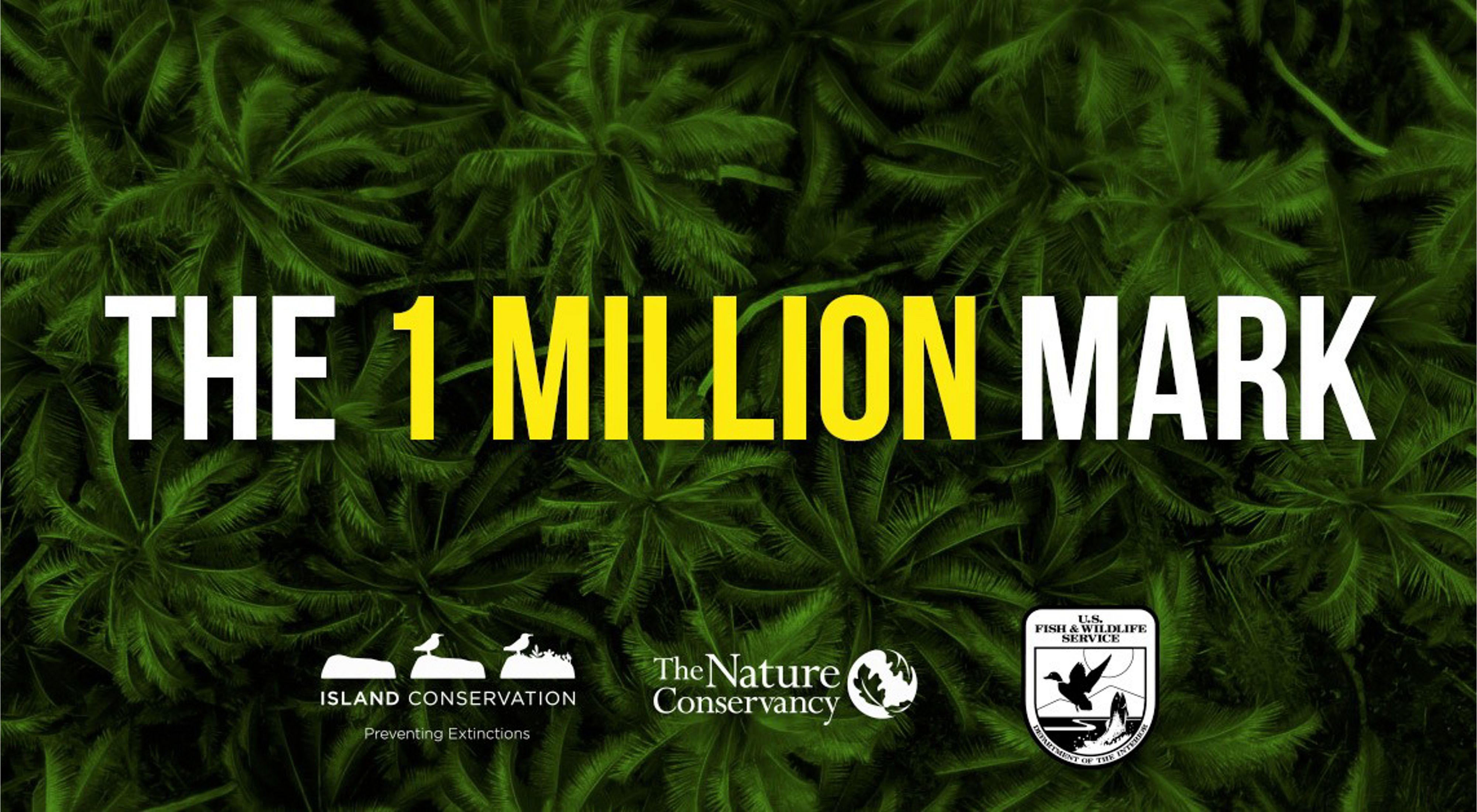Conservation Partners Reach New Milestone at Palmyra Atoll with the Removal of One Million Invasive Palms
Media Contacts
-
Evelyn Wight
The Nature Conservancy
Phone: 808-587-6277
Email: ewight@tnc.org
On October 21, 2021, field staff and volunteers from the U.S. Fish and Wildlife Service (USFWS), Island Conservation and The Nature Conservancy (TNC) reached the halfway point in efforts to control introduced coconut palms on the atoll to allow for recovery of native rainforest.
“The bulk of the credit for this accomplishment goes to the 25 full time volunteers who dedicated months of their lives to living at Palmyra and together accumulated over 4,700 person hours of manual labor, as well as to our staff and partners who continue to support the mission,” says Stefan Kropidlowski, Deputy Superintendent with the U.S. Fish and Wildlife Service. “We still have a lot of work to do but just taking a moment to acknowledge the progress that has been made is inspiring.”
Located 1,000 miles south of Hawai‘i in the Central Pacific Ocean, Palmyra Atoll—a USFWS National Wildlife Refuge, TNC Preserve and Mission Blue Hope Spot—has been transformed through attempts at copra (coconut) farming in the mid-19th century. Later, WWII-era dredging and land reclamation brought other threats, including rats and mosquitoes, which further degraded the landscape over time.

Almost immediately following the successful removal of rats in 2011, invasive coconut palms sprang up across the atoll. Without rats to eat them, rapidly growing coconut palms formed dense stands, outcompeting native trees. By 2016, an estimated 29,000 adult palms and two million seedlings covered the atoll’s islands. To reverse the palm’s dominance and restore Palmyra’s native rainforest, the three conservation partners initiated the Palmyra Atoll Rainforest and Reef Resilience Project (PARP) in April 2019.
“Palmyra Atoll allows us to test removal methods for invasive coconut palms and monitor the recovery of native vegetation, potentially developing a roadmap that could advance island restoration goals on atolls across the Pacific,” says Mele Khalsa, Island Restoration Specialist with Island Conservation.
Vegetation recovery is a critical PARP goal because branching native trees provide more suitable habitat for native seabirds. Roosting in the native trees, seabirds’ nutrient-rich guano seeps into the surrounding land and marine environment, feeding phytoplankton which in turn nourish fish and corals. The team is restoring the native tropical rainforest by replacing approximately two million palms with native trees. Today, the operation reached a significant milestone, surpassing one million palms!

In late 2020, Pisonia grandis, a native tree favored by seabirds for nesting, underwent a masting event—dispersing seeds across the atoll in numbers not seen in almost a decade. To supplement the natural recovery, field teams are growing seedlings and hand-planting native tree species where invasive palms have been removed.
Restoring the native rainforest will enhance rainforest and coral reef resilience to climate change impacts. Palmyra’s remoteness provides a natural laboratory to study climate resilience and better understand the cascading benefits of protecting island ecosystems.
“Our work to reinstate Palmyra’s native rainforest provides opportunities to better understand the land and sea connection and identifies best practices that can help other coastal areas around the world adapt to climate change,” says Katie Franklin, Science Manager for TNC’s Palmyra Program.

Despite the pandemic, PARP partners and volunteers made significant progress over the last two years, controlling one million palms, about half the target. Completion of the project to control the remaining million trees is estimated by 2024.
Images and video are available here: https://www.flickr.com/photos/usfwspacific/sets/72157719970146974/
Island Conservation is a global, not-for-profit conservation organization that prevents extinctions and restores islands. We work where the concentration of both biodiversity and species extinction is the greatest – islands. Removing a primary threat – introduced invasive vertebrates – is one of the most critical interventions for saving threatened plants and animals. Native island species and ecosystems often recover with little additional intervention, and when animals have gone locally extinct, we reintroduce them. Island Conservation assists land managers and local communities to implement their visions. To date, we have successfully restored 65 islands worldwide, benefiting 1,218 populations of 504 species and subspecies. Visit islandconservation.org
U.S. Fish and Wildlife Service works with others to conserve, protect, and enhance fish, wildlife, plants, and their habitats for the continuing benefit of the American people. For more information, visit www.fws.gov/pacificislands
The Nature Conservancy is a global conservation organization dedicated to conserving the lands and waters on which all life depends. Guided by science, we create innovative, on-the-ground solutions to our world’s toughest challenges so that nature and people can thrive together. We are tackling climate change, conserving lands, waters and oceans at an unprecedented scale, providing food and water sustainably and helping make cities more sustainable. The Nature Conservancy is working to make a lasting difference around the world in 81 countries and territories (40 by direct conservation impact and 41 through partners) through a collaborative approach that engages local communities, governments, the private sector, and other partners. To learn more, visit nature.org or follow @nature_press on X.
